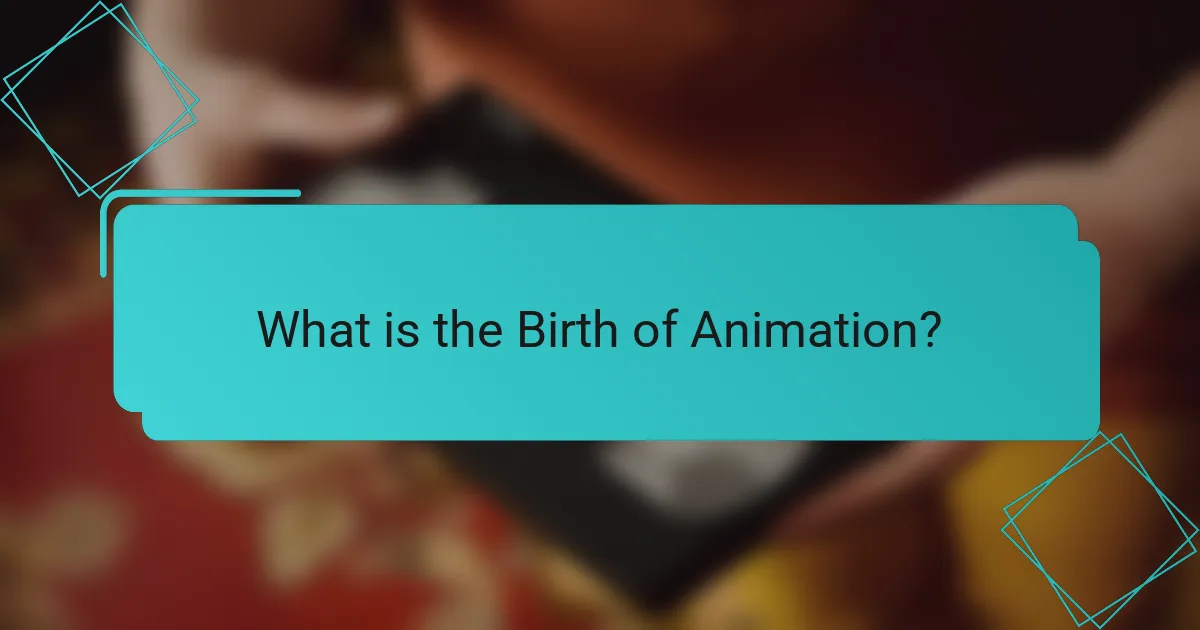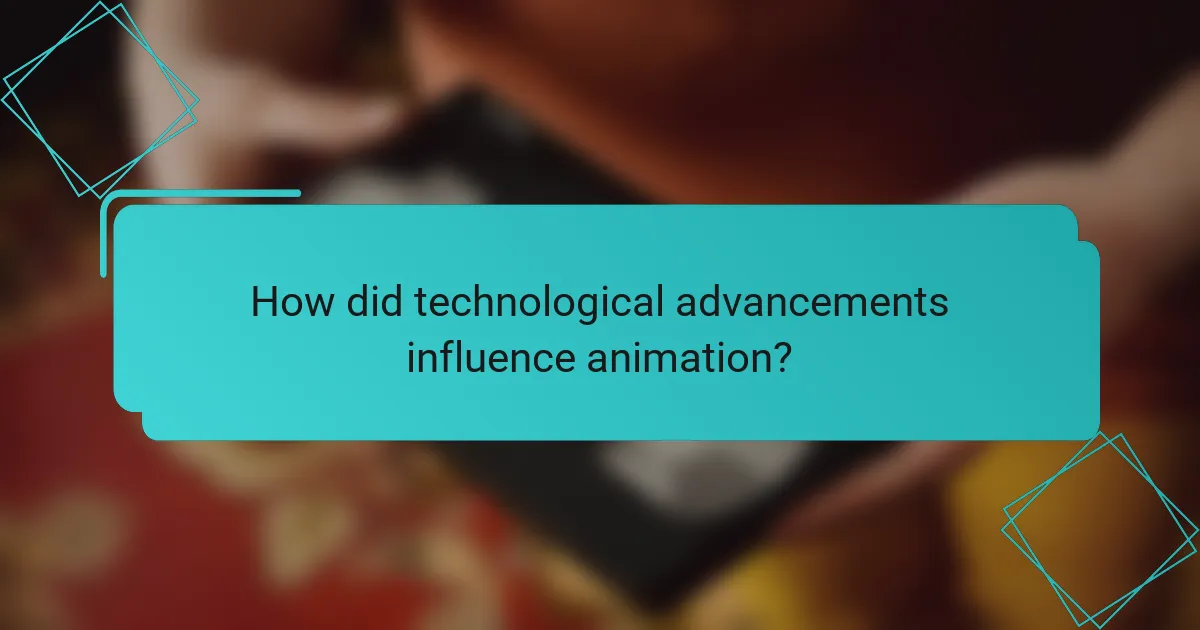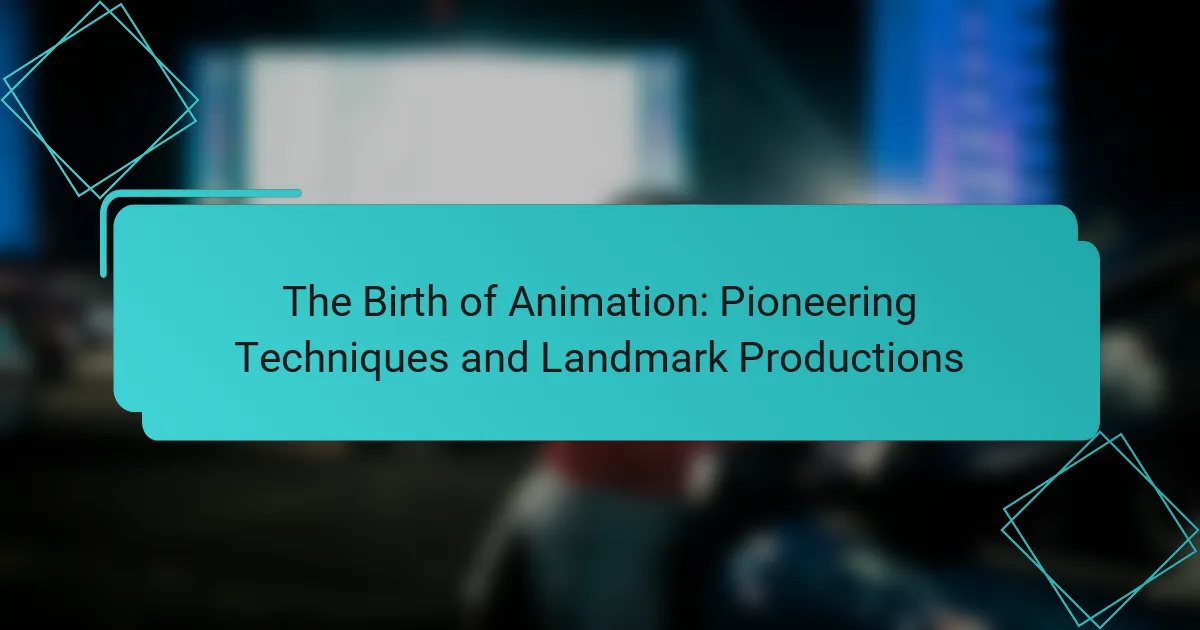The article explores the birth of animation, highlighting its inception in the late 19th century and the contributions of early pioneers such as Émile Cohl and J. Stuart Blackton. Key developments include Cohl’s 1908 film “Fantasmagorie,” which showcased hand-drawn images, and Winsor McCay’s introduction of the cel technique in “Gertie the Dinosaur” in 1914. The evolution of animation is further examined through technological advancements like computer-generated imagery (CGI) and motion capture, which have enhanced production quality and accessibility. Additionally, the article discusses how early animation laid the groundwork for modern storytelling techniques and character development, influencing the multimedia landscape of film and television today.

What is the Birth of Animation?
The birth of animation refers to the inception of creating moving images through various techniques. This process began in the late 19th century. Early pioneers included Émile Cohl and J. Stuart Blackton. They utilized simple drawings and stop-motion techniques. The first animated film is often credited to Cohl’s “Fantasmagorie” in 1908. This film featured a series of hand-drawn images that created a fluid motion. Animation evolved with innovations like the cel technique introduced by Winsor McCay in “Gertie the Dinosaur” in 1914. These advancements laid the foundation for modern animation practices.
How did animation originate as an art form?
Animation originated as an art form in the late 19th century. Early techniques included the use of sequential images and devices like the zoetrope. These devices created the illusion of motion by displaying a series of still images in rapid succession. The first animated film is often credited to Émile Cohl’s “Fantasmagorie” in 1908. This short film featured hand-drawn characters and was groundbreaking for its time. Animation evolved further with the introduction of cel animation in the 1910s. This method allowed for more complex and colorful animations. The development of synchronized sound in the late 1920s, exemplified by Disney’s “Steamboat Willie,” revolutionized the medium. These innovations laid the foundation for modern animation as a recognized art form.
What historical contexts contributed to the development of animation?
The development of animation was influenced by several historical contexts. The invention of the phenakistoscope in 1832 marked a significant technological advancement. This device created the illusion of motion through a series of images viewed in succession. The emergence of the zoetrope in the 1860s further contributed to this evolution, allowing multiple viewers to experience animated sequences.
In the late 19th century, the advent of motion picture technology provided a platform for animation to flourish. The first animated short film, “Gertie the Dinosaur,” was created by Winsor McCay in 1914, showcasing the potential of animation in storytelling. The establishment of animation studios in the early 20th century, such as the Fleischer Studios, played a crucial role in popularizing animated characters.
The rise of comic strips and caricatures in newspapers also influenced animation’s development. These visual narratives paved the way for characters that would later transition into animated films. The combination of artistic innovation and technological advancements created a fertile ground for the growth of animation as a distinct art form.
Who were the key figures in the early days of animation?
Key figures in the early days of animation include Winsor McCay, J. Stuart Blackton, and Émile Cohl. Winsor McCay created the iconic “Gertie the Dinosaur” in 1914. This film showcased his pioneering techniques in animation. J. Stuart Blackton is known for “Humorous Phases of Funny Faces” from 1906. His work helped establish animation as an art form. Émile Cohl produced “Fantasmagorie” in 1908, regarded as one of the first animated films. These individuals played crucial roles in developing animation techniques and storytelling. Their contributions laid the groundwork for future advancements in the field.
What pioneering techniques were used in early animation?
Early animation utilized several pioneering techniques. One significant method was the use of stop-motion photography. This technique involved capturing individual frames of objects or puppets in slightly different positions. When played in sequence, these frames created the illusion of movement.
Another technique was hand-drawn animation. Artists created a series of drawings on transparent sheets, known as cels. These cels were layered over painted backgrounds. This method allowed for fluid motion and colorful visuals.
The invention of the phenakistoscope also played a crucial role. This device created the illusion of motion through a spinning disk with sequential images. When viewed through slits, the images appeared to animate.
Additionally, the use of live-action combined with animation emerged. This technique blended real footage with animated elements, enhancing storytelling. Notable examples include the works of early filmmakers like Georges Méliès.
These techniques laid the foundation for modern animation. They demonstrated innovative ways to bring static images to life. Each method contributed to the evolution of the animation industry.
How did traditional techniques like hand-drawn animation evolve?
Traditional techniques like hand-drawn animation evolved through advancements in technology and artistic innovation. Initially, hand-drawn animation involved creating individual frames on paper. Each frame was meticulously drawn by artists, leading to labor-intensive production processes. The introduction of the animation camera in the early 20th century allowed for more efficient capturing of these frames. Innovations such as the multiplane camera enhanced depth and realism in animated scenes. The transition to cel animation in the 1910s streamlined production by allowing artists to reuse backgrounds. The advent of computer technology in the late 20th century led to digital animation, further transforming the field. Today, traditional hand-drawn techniques coexist with digital methods, showcasing the evolution of animation art.
What role did stop-motion play in the birth of animation?
Stop-motion was a foundational technique in the birth of animation. It allowed filmmakers to create the illusion of movement by capturing a series of still images. Each frame represented a slight change in position of the subject. When played in sequence, these frames produced fluid motion. Early pioneers like J. Stuart Blackton and Emile Cohl utilized stop-motion in their works. Blackton’s “Humorous Phases of Funny Faces” (1906) showcased its potential. Cohl’s “Fantasmagorie” (1908) further demonstrated its capabilities. This technique laid the groundwork for future animation styles. It established principles that are still used in animation today.
What landmark productions defined the early animation era?
Landmark productions that defined the early animation era include “Gertie the Dinosaur,” “Steamboat Willie,” and “The Adventures of Prince Achmed.” “Gertie the Dinosaur,” created by Winsor McCay in 1914, is often regarded as the first animated character with personality. “Steamboat Willie,” released by Walt Disney in 1928, was one of the first synchronized sound cartoons. “The Adventures of Prince Achmed,” directed by Lotte Reiniger in 1926, is noted for its silhouette animation and is the oldest surviving feature-length animated film. These productions showcased innovative techniques and set the foundation for future animation developments.
Which films are considered milestones in animation history?
Milestone films in animation history include “Steamboat Willie,” “Snow White and the Seven Dwarfs,” and “Toy Story.” “Steamboat Willie,” released in 1928, marked the debut of synchronized sound in animation. “Snow White and the Seven Dwarfs,” released in 1937, was the first feature-length animated film. It showcased Disney’s pioneering use of color and storytelling. “Toy Story,” released in 1995, was the first entirely computer-animated feature film. Each of these films significantly advanced the animation industry and set new standards for storytelling and technology.
What impact did these productions have on the industry?
These productions revolutionized the animation industry by introducing groundbreaking techniques. They established foundational methods that are still in use today. For example, the use of synchronized sound in “Steamboat Willie” set a new standard for animated films. The success of these early productions led to increased investment in animation as a viable entertainment medium. This influx of funding allowed for more complex storytelling and character development in subsequent works. The innovations from these productions inspired future generations of animators. They paved the way for the emergence of feature-length animated films. Overall, their impact was profound, shaping the trajectory of animation as an art form.

How did technological advancements influence animation?
Technological advancements significantly influenced animation by enhancing its production quality and accessibility. The introduction of computer-generated imagery (CGI) in the 1990s transformed animation, allowing for more complex and realistic visuals. Software like Adobe Flash and Toon Boom Revolutionized traditional animation techniques, streamlining the animation process. The development of motion capture technology enabled animators to create lifelike movements, as seen in films like “Avatar.” Additionally, advancements in rendering technology improved the visual fidelity of animated films. The rise of digital platforms has democratized animation, making it accessible to independent creators. These advancements collectively expanded the creative possibilities within the animation industry.
What technologies revolutionized the animation process?
Digital animation software revolutionized the animation process. Tools like Adobe Animate and Toon Boom Harmony allow for faster and more versatile animation creation. Computer-generated imagery (CGI) transformed traditional animation by introducing 3D modeling and rendering. Technologies such as motion capture enable animators to create realistic character movements. The introduction of non-linear editing systems improved the efficiency of animation production. Additionally, advancements in graphics processing units (GPUs) enhanced rendering speeds and visual quality. These technologies collectively changed how animation is produced and consumed.
How did the introduction of sound change animated films?
The introduction of sound revolutionized animated films by adding a new dimension of storytelling. It allowed for synchronized dialogue, music, and sound effects, enhancing emotional engagement. The first successful sound cartoon, “Steamboat Willie,” premiered in 1928. This film featured synchronized sound, which captivated audiences and set a new standard. Sound enabled characters to express themselves verbally, making them more relatable. It also facilitated the development of musical scores tailored to the animation. As a result, animated films became more immersive experiences. The integration of sound ultimately led to the growth of the animation industry and its popularity.
What advancements in animation software emerged in the late 20th century?
In the late 20th century, significant advancements in animation software transformed the industry. Notable developments included the introduction of computer-generated imagery (CGI) software. This software allowed animators to create 3D models and environments. Programs like Autodesk Maya and Pixar’s RenderMan revolutionized the animation process. They enabled more detailed and realistic animations. Additionally, the rise of non-linear editing software improved the editing process for animated films. This software facilitated easier manipulation of scenes and sequences. The combination of these advancements led to a new era of animation. Iconic films such as “Toy Story” showcased the potential of these technologies. These innovations set the foundation for modern animation practices.
How did animation styles diversify over time?
Animation styles diversified over time through technological advancements and artistic experimentation. Early animation was primarily characterized by hand-drawn techniques, such as those used in “Gertie the Dinosaur” (1914). The introduction of synchronized sound in “Steamboat Willie” (1928) marked a significant shift, blending audio with visual storytelling. The use of color in animated films began with “Flowers and Trees” (1932), enhancing visual appeal.
In the mid-20th century, limited animation techniques emerged, as seen in TV shows like “The Flintstones” (1960), focusing on cost efficiency. The late 20th century saw the rise of computer-generated imagery (CGI), revolutionizing animation with films like “Toy Story” (1995).
Global influences also contributed to diversification, with Japanese anime introducing unique styles and narratives. The 21st century has further expanded animation styles, incorporating hybrid techniques and diverse cultural stories. Each of these developments reflects a broader range of artistic expression and technological innovation in animation.
What are the different styles of animation that emerged in the 20th century?
The different styles of animation that emerged in the 20th century include traditional animation, stop-motion animation, and computer-generated imagery (CGI). Traditional animation involves hand-drawn frames, exemplified by early Disney films like “Snow White and the Seven Dwarfs” released in 1937. Stop-motion animation uses physical models, as seen in works like “The Nightmare Before Christmas,” released in 1993. CGI revolutionized animation with films like “Toy Story,” which debuted in 1995 and marked the first fully computer-animated feature film. Each style has distinct techniques and historical significance, shaping the evolution of animated storytelling throughout the century.
How did cultural influences shape these animation styles?
Cultural influences significantly shaped animation styles through storytelling, aesthetics, and themes. Different cultures brought unique narratives and visual styles to animation. For instance, Japanese anime often incorporates elements of traditional art and folklore. This reflects the cultural heritage and values of Japan. Similarly, Western animation has roots in comic strips and theatrical performances. These influences led to distinct styles like Disney’s family-friendly narratives. Cultural events and societal changes also impacted animation. For example, the rise of feminism in the 20th century influenced character portrayals in animations. Overall, cultural context has been crucial in defining the evolution of animation styles across the globe.

What legacy did early animation leave on modern media?
Early animation laid the groundwork for modern media by introducing storytelling techniques and visual styles. Pioneers like Walt Disney and Max Fleischer established character development and narrative arcs. The use of synchronized sound in films like “Steamboat Willie” revolutionized audience engagement. Techniques such as rotoscoping and stop-motion animation originated in early works and are still utilized today. The success of early animated features led to the expansion of animated genres across various platforms. Additionally, early animation influenced the incorporation of humor and emotional depth in contemporary storytelling. The legacy of early animation is evident in the multimedia landscape, shaping both film and television.
How does the influence of early animation persist in contemporary works?
The influence of early animation persists in contemporary works through techniques and stylistic choices. Many modern animators draw inspiration from the hand-drawn aesthetics of early animation. This includes the use of frame-by-frame animation, which remains popular today. Early animation’s emphasis on character expression and exaggerated movements also continues to shape character design. Iconic characters from early animation have become cultural touchstones, influencing new creations. Additionally, storytelling techniques established in early works, such as simple narratives and visual humor, are prevalent in contemporary storytelling. The revival of retro animation styles in recent series and films demonstrates this ongoing influence. Thus, early animation’s legacy is evident in both the methods and themes of current animated content.
What lessons can modern animators learn from early pioneers?
Modern animators can learn the importance of storytelling from early pioneers. Pioneers like Walt Disney emphasized narrative as the backbone of animation. They demonstrated that compelling stories engage audiences more effectively than visuals alone.
Additionally, early animators showcased the value of innovation in techniques. For example, techniques like rotoscoping were developed to enhance realism. This approach can inspire modern animators to experiment with new methods.
Moreover, pioneers focused on character development. Characters like Mickey Mouse became iconic due to their relatability and personality. Modern animators can benefit from creating memorable characters that resonate with viewers.
Finally, early animators taught the significance of perseverance. Many faced challenges in technology and funding but continued to push boundaries. This resilience is a vital lesson for today’s animators navigating a competitive landscape.
What are the best practices for studying the history of animation?
The best practices for studying the history of animation include analyzing key milestones and influential figures. Focus on landmark productions like “Steamboat Willie” and “Snow White.” Examine pioneering techniques such as stop-motion and cel animation. Utilize academic resources like books and peer-reviewed articles. Engage with documentaries that showcase the evolution of animation. Participate in workshops to gain practical insights. Join online forums and communities to discuss findings with peers. Attend animation festivals for firsthand experiences and networking opportunities. These practices provide a comprehensive understanding of animation’s rich history.
How can understanding early animation techniques enhance modern animation skills?
Understanding early animation techniques can significantly enhance modern animation skills. Early techniques, such as hand-drawn frames and stop-motion, laid the foundation for current practices. Familiarity with these methods fosters a deeper appreciation for animation’s evolution. This knowledge encourages animators to experiment with traditional styles. It also promotes innovative storytelling approaches rooted in historical context. Mastery of fundamentals from early animation can improve timing and movement in modern work. Techniques like squash and stretch, derived from early practices, remain vital in character animation today. Historical insights can inspire unique visual styles in contemporary projects.
What resources are available for further exploration of animation history?
Books, documentaries, and online archives are available for further exploration of animation history. Key books include “Of Mice and Magic” by Leonard Maltin, which covers the history of animation from its inception. “Animation: A History” by Giannalberto Bendazzi offers a comprehensive overview of the medium’s development. Documentaries such as “The Pixar Story” provide insights into the evolution of animation techniques. Online resources include the Animation Research Library, which houses a vast collection of animation art and history. The Library of Congress also offers digital collections related to animation. These resources collectively enhance understanding of animation’s pioneering techniques and landmark productions.
The Birth of Animation focuses on the inception of creating moving images, tracing its origins to the late 19th century with pioneers like Émile Cohl and Winsor McCay. Key techniques such as stop-motion photography, hand-drawn animation, and the introduction of synchronized sound are explored, highlighting landmark productions like “Fantasmagorie,” “Gertie the Dinosaur,” and “Steamboat Willie.” The article examines how these innovations established animation as a recognized art form and influenced modern practices, while discussing the impact of technological advancements on the evolution of animation styles. Additionally, it outlines the legacy of early animation and the lessons contemporary animators can learn from these foundational figures and techniques.
